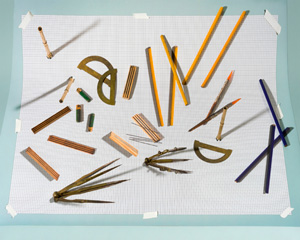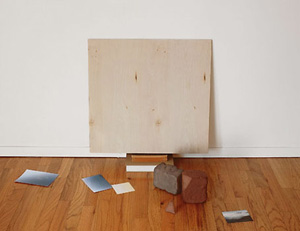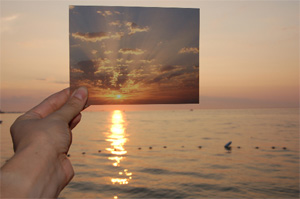The New Old Photography
John Haberin New York City
New Photography 2015 and Photo-Poetics
With "New Photography 2015," the Museum of Modern Art wants you to know: it still cares.
It cares enough about the medium to track its currents. Maybe it has to make a point of that, now that that "Greater New York" at MoMA PS1 has all but given up on emerging. It cares, too, about its heritage. It cares enough to extend the show to a stairwell that once provided chief access to the museum itself. It recalls the museum's former grandeur and intimacy in papering the walls with its history. Why, then, does it seem so trapped in a more cynical recent past and so devoid of photographs? 
Other photographers still love the medium—so much that they use it twice. They nurture snapshots from family and friends. They hold them in their hands and pin them to the wall. They seek them out on the Web. They cling to album covers and newspaper clippings from long ago. And then they pull out the camera.
"Photo-Poetics: An Anthology" takes to photography and other seemingly dated media. Most of its artists work in series or with actual slide shows, one starting the very year that Kodak stopped making slides. They are not, though, conducting exercises in nostalgia, for all the quaintness of "poetics" and "an anthology." (Vinyl, you know, is having a comeback.) The Guggenheim, which has not been collecting photography all that long, can hardly afford nostalgia anyway. It is interested in the passage of time, as how people define themselves in the present.
Disaster area
Some of the stairwell images, by Katharina Gaenssler, capture the actual Bauhaus stairs and some Oskar Schlemmer's painting of them from 1932, just three years after he left the Bauhaus—and shortly before the Nazis closed it and its "degenerate art" for good. The painting long welcomed visitors to MoMA up its stairs, before it redirected visitors to something more akin to a shopping mall. Yet this, too, is no exercise in nostalgia. Gaenssler throws in still another take on the stairs, by Roy Lichtenstein, in a chain of reproductions with no definite beginning or ending. She sticks to photocopies at that, in black and white.
She is one of nineteen in a vision of photography that has all but outgrown photographs. They play at most an incidental role in Lele Saveri's pop-up newsstand, which stood briefly by the L train in Williamsburg. He is much more interested in a Brooklyn attitude, with pretend magazines headlined Karma, XXX, and Stoned Again. Yuki Kimura has photographs, but on metal armatures as a 3D tour of an Edo-period Japanese estate, complete with potted plants. Katja Novitskova transfers her colors to freestanding aluminum cutouts, like outtakes from Frank Stella, while Indre Serpytyte converts his photos of KGB interrogation sites into carved wood, which he then rephotographs. They have little in common with the faceless modernity of Soviet architecture, apart from their felt isolation against backgrounds dark as an early morning sky.
Others make the obligatory move to social media, much as New Photography 2023" will bring the news from Lagos. Anouk Kruithof directs the harsh flash of an iPhone, while David Horvitz goes viral with his image, head in hands. Yet more often the show again looks back. Basim Magdy turns to old film stock for Brooklyn along the Gowanus Canal, where Duke Riley cleans house, while Edson Chagas stacks paper images of Angola for visitors to take away. David Hartt dwells on a conservative think tank as a repository of cubicles and folders. Lucas Blalock applies the Photoshop stamp tool, but to abstract away from a monumental American landscape.
They look back not just to MoMA's past, but also to a vanishing critique of art. If Pop Art saw mass culture and mass reproduction as shocking and thrilling, the 1980s saw it as undermining the very hope of a shared identity. And sure enough, Quentin Bajac, Lucy Gallun, and Roxana Marcoci call this year's selection "Ocean of Images." For them as curators, photography and the photographed are drowning together. Like new media for Jacob Kirkegaard, they linger on global disaster areas, from the Gowanus to Japan after a tsunami. Lieko Shiga leans ghostly prints against the wall as if they, too, washed up with the rising waters.
Here photography is subordinate to conceptual art, while conceptual art takes on physical dimensions. Saveri's pop-up enterprise and Horvitz's despair have their counterparts in Marina Pinsky's child at a convenience store and man in a bus shelter. Mishka Henner maps what Blaise Pascal called the "silence of infinite spaces." The pages of his Astronomical have more than their share of blackness. Zyynek Baladrán's video sets telescope views on fire. Shiga's tall frames bring out the rootlessness of people and trees.
Far too much feels caught in a time warp, back when it meant something to reconceive art and culture as a disaster area. Natalie Czech illustrates poetry with the "Pictures generation," and Ilit Azoulay with traffic signs revisits the empty frames of Allan McCollum from back then, but will anyone still care? DIS, a collective, superimposes MoMA's logo on an androgynous Europop star, but to what end? If the museum is selling out, surely it could set a higher price. At least John Houck constructs his still lifes from graph paper and drafting tools—and do not forget the disparities in John Houck in painting. New photography deserves a show better able to take its measure.
Home Away from home
A love affair must sound like a given, but it is not. Sure, photographers had better take an interest in photography, but who knows what that means anymore? The generation of Cindy Sherman and Sherrie Levine established photography as more political than physical presence. It was something to be restaged and reshot. Critics spoke of the "dematerialization of the image," and MoMA still has its "Ocean of Images." It includes more in the way of logos and music videos than stills.
With "Photo-Poetics," photography is back, but watch your back. Something else then comes into question, the image. For Claudia Angelmaier, it becomes a big, beautiful blur. She presents the backs of postcards, waiting for her inscription—or yours. In each, though, one can discern a woman in the soft shades of white. These are museum postcards, of nudes by J. A. D. Ingres and a woman in red named Betty.
 They are, as Walter Benjamin had it, "the work of art in an age of mechanical reproduction," but also personal. For a German like Angelmaier, Betty is almost as recognizable as Ingres, thanks to the 1988 portrait of his daughter by Gerhard Richter. The type identifies the postcard manufacturer as German, too. Richter borrows the pose from Ingres, and one of those nudes is actually Le Violon d'Ingres by Man Ray, complete with sound holes. The size of the prints matches precisely the size not of the postcards, but of the paintings. Angelmaier plays with photography but also with painting, daring one to ask which matters more.
They are, as Walter Benjamin had it, "the work of art in an age of mechanical reproduction," but also personal. For a German like Angelmaier, Betty is almost as recognizable as Ingres, thanks to the 1988 portrait of his daughter by Gerhard Richter. The type identifies the postcard manufacturer as German, too. Richter borrows the pose from Ingres, and one of those nudes is actually Le Violon d'Ingres by Man Ray, complete with sound holes. The size of the prints matches precisely the size not of the postcards, but of the paintings. Angelmaier plays with photography but also with painting, daring one to ask which matters more.
The result is intensely physical, but also at a remove. It is layered, with both sides of the postcard—and with layers of reproduction, reference, and history. It is the photographic object, as material, dematerialized, and rematerial again. It is open to beauty, but as seen through language, culture, and the artist, not unlike a poem. It is uncanny, too, to borrow a term for the terror of the familiar from Sigmund Freud. The German unheimlich translates literally or maybe cannily as "away from home," not unlike a tourist collecting postcards.
Much the same applies to all ten artists, in work from just the last few years. The curator, Jennifer Blessing, gives them rooms to themselves, but with plenty of common ground. Two photographers hold pictures of sunsets in their own hands, and two borrow the title Crépuscule, the French for twilight—in one case from a poet, E. E. Cummings. Two look out at the rivers to either side of Manhattan, and two fade into a painterly white. One photographs Minimalist sculpture and another her own prism-like constructions in concrete and human ashes. Nine are women, and images of women abound.
Just to list their recent appearances in New York (and in greater depth on this Web site) brings out their shared themes. Erica Baum and Sara VanDerBeek appeared in a show called "Chick Lit," Anne Collier in "Strange Magic." They are concerned for gender, as something that photography continually makes vital and strange. Collier and Moyra Davey appeared in "The Feverish Library" and Lisa Oppenheim in "The Last Newspaper," for here media are dying only after a long fever. Oppenheim appeared at MoMA in its previous "New Photography" in 2013, Elad Lassry at the New Museum in its 2009 "Generational," and Leslie Hewitt as artist in resident at the Studio Museum in Harlem in 2008. Step back a moment, for new photography five or ten years after.
Sunrise, sunset
Kathrin Sonntag, also from Germany, finds the uncanny right in her studio, with slides meant to evoke spirit photography. That superstition arose while the medium was still young and strange, and after the ubiquity of the digital it may become strange again. She, like Angelmaier, also looks to art as artifact of wealth and culture, with the auction catalog for the Guggenheim estate. VanDerBeek, photographs her own delicate constructions of metal and museum reproductions. One assemblage includes a magazine clipping of a birth-control pill, as shadowy and monumental as a tomb. Whose ideals of civilization and autonomy will survive?
The daughter of Stan VanDerBeek, she knows poetry as art at first hand, and she has previously visited New Orleans as sites of recovery. Hewitt, too, meditates on architecture and community, with faded snapshots from the time of the civil rights movement, set against landscape and wooden frames. Like their materials, they carry more warmth than hope. So do Baum's near abstract collages of old paperbacks and The New York Times. They become a found poetry, of what "captured the public imagination" and "remains to be said," even as actors look out from the narrow spaces between the lines as from the Venetian blinds in a film noir. Hewitt also takes her frames into the room, leaning against the wall both in images and, at times, in life. 
Hewitt calls her work Riffs on Real Time, and Baum's paperbacks describe something as mundane as the weather. What, though, is real time and what the time of poetry and art? For Collier, The Sun Is Always Setting Somewhere Else. She holds photos of sunsets in Iraq and Afghanistan, taken by soldiers, against actual sunsets, which in her slide show will never fade altogether into night. She also makes the most direct engagement with Sherman's generation, with classic blonds from Ingrid Bergman in tears to Cheryl Tiegs with a camera as extensions of herself. Sherman appears twice over, on the cover of L'Uomo, dressed suitably enough as a fashionable European man.
Lassry takes on Hollywood values less directly, through objects of desire against saturated backgrounds and lacquered frames. He alone uses inkjet prints exclusively, rather than photography the old-fashioned way. Davey has her goddesses, too, but not the kind on film. Rather, she composes photo essays on Mary Wollstonecraft's daughters and her mother's bookshelf. The first indeed styled themselves Les Goddesses, but that is a long time ago, and the show still comes down to the gap between real time and an anthology. The gap keeps vanishing, only to emerge again.
It does so on video for Erin Shirreff, with the very emblem of New York as a site of global interchange. Elsewhere, Shirreff has explored affinities between Minimalism and landscape. Here she seems to show nothing more than a static image of the United Nations, until it begins to darken or to fill with light. Is it sunrise or sunset? It is only a set of still photos after all, like interiors between photography and painting by Willa Nasatir, and the flashes bring out their grain. Photography recognizes its limits, in what will endure and what will change.
Here static images multiply in time in order to convey stasis. Angelmaier also photographs a virtual wall of photographs, after a watercolor of a rabbit by Albrecht Dürer. Each is in the open spread of a book, an adjacent book hiding its facing page and any text. Each, too, differs in size, background, color, and resolution, as reproductions will. Once again, she cannot get enough of photography. Just do not expect it to be any more trustworthy, any more explicit in its poetry, or any less alive.

"New Photography 2015" ran at The Museum of Modern Art through March 20, 2016, "Photo-Poetics" at The Solomon R. Guggenheim Museum through March 27. These reviews first appeared in New York Photo Review.




